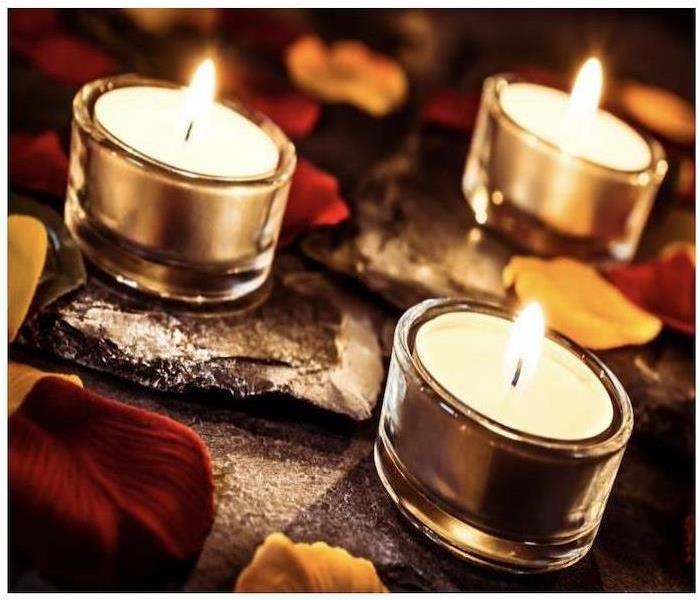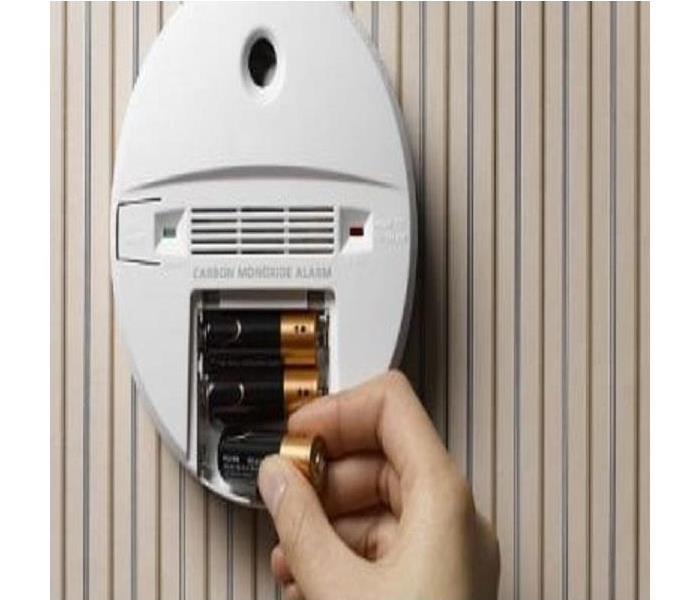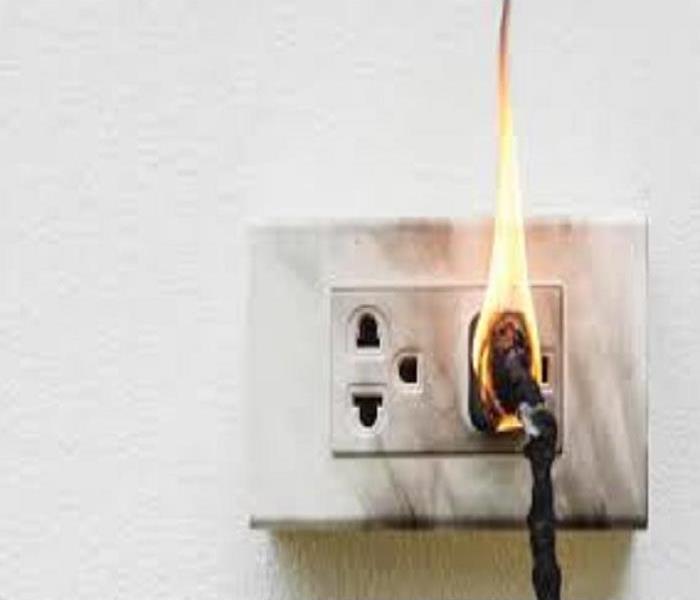Archived Fire Damage Blog Posts
Fire Safety Equipment
11/1/2023 (Permalink)
 Use these fire safety tools to protect your home, family, and pets from fire, smoke, and poisonous carbon monoxide gas
Use these fire safety tools to protect your home, family, and pets from fire, smoke, and poisonous carbon monoxide gas
Fires can start in a variety of ways, which includes faulty electrical wiring, lightning strikes, cigarette smoking, cooking mishaps, dryer vent ignition, gas furnace ignition, fireplace ignition, portable heater tip-overs, and so forth. Fires can smolder for hours before suddenly erupting into flame. If you have an electrical fire, a fire extinguisher, sand, and baking soda can be used once the electrical source of the fire has been disrupted.
Fire Extinguishers
Fire extinguishers are classified by ratings of A, B, and C. These ratings determine the size and type of fire that the extinguisher can put out as follows:
- A type fires—they consist of burning wood, paper, and fabric.
- B type fires—they consist of flammable liquids, such as gasoline and oil.
- C type fires—they are electrical.
The number that precedes the letter determines how big of a fire the extinguisher can put out in increments of 2.5 feet. For example:
- A 10-B:C extinguisher—it can put out a 25-square foot fire from a flammable liquid or electrical source.
- A 5-B:C extinguisher—it can handle a 12.5-foot fire from a flammable liquid or electrical source.
Smoke Alarms
There are two basic types of smoke detectors as follows:
- Ionization smoke alarms—they are better at detecting small particles that are produced in greater amounts in flaming fires, which quickly consume combustible materials and spread in many directions.
- Photoelectric smoke alarms—they are better at detecting large particles that are produced in greater amounts in smoldering fires, which may smolder for hours before bursting into flame.
Both types are effective in detecting smoke and fire, but the best smoke alarms feature both technologies.
Carbon Monoxide Detectors
Carbon Monoxide (CO) is a toxic, colorless, odorless, poisonous gas that comes from an appliance malfunction and burning fossil fuels, such as oil, gas, and coal. A furnace crack, dryer vent clog, and a blocked chimney can all produce CO. Use carbon monoxide alarms to detect a leak quickly.
Under normal operation, a carbon monoxide detector is able to vent the small amounts of CO gas that is produced outside of your home. However, small amounts of CO gas can build up and become a life-threatening problem when the vents are blocked.
Carbon monoxide deprives you of oxygen that your blood depends on to sustain life. If you are exposed to even small amounts of CO, then it quickly bonds with hemoglobin in your blood and displaces oxygen. When this occurs, you experience flu-like symptoms, such as headaches, fatigue, nausea, dizzy spells, confusion, and irritability. As more time passes, the symptoms can worsen to include vomiting, loss of consciousness, brain damage, and even death. Place a CO detector in every bedroom, living room, and basement in your home to prevent carbon monoxide poisoning.
There are two fire extinguishers and three 10-year battery smoke alarms.
Use these fire safety tools to protect your home, family, and pets from fire, smoke, and poisonous carbon monoxide gas.
Important Candle Safety Information
7/8/2022 (Permalink)
 Prevent fire hazards from candles but contact SERVPRO® of Panthersville at (678) 515-8602 if your property has fire damages.
Prevent fire hazards from candles but contact SERVPRO® of Panthersville at (678) 515-8602 if your property has fire damages.
Fire Hazard can Occur from a Candle and so Tips to Prevent Fire and Serious Injury
- Before you light a candle ensure that you do as follows:
- Always trim wick to ¼ inch before lighting—dispose of wick trimmings and matches to keep debris out of wax pool.
- Avoid drafts
- Set candle on heat-resistant surface
- While the candle is lit ensure that you do as follows:
- Burn within sight—always remain within line of sight of burning candles. Extinguish candles before leaving room. Never burn for longer than four-hour intervals.
- Keep away from things that catch fire—never burn candles on or near anything that can catch a fire.
- Keep away from children and pets—children and pets could accidentally tip candle over.
- After use of the candle ensure that you do as follows:
- Do not extinguish with water.
- Always allow wax to harden before relighting, touching, or moving.
Fire or Smoke Damage Tips
7/1/2022 (Permalink)
 Do not hesitate to contact SERVPRO® of Panthersville at (678) 515-8602 if you encounter fire or smoke damages!
Do not hesitate to contact SERVPRO® of Panthersville at (678) 515-8602 if you encounter fire or smoke damages!
Severe fire damages can be the most devastating thing to happen to any property when disaster strikes. Consequently, you have most likely lost some personal belongings and areas of your home are destroyed. The following tips can assist you when notifying your insurance company about a fire loss claim:
Check Your Policy
Although you have replacement coverage for your home, you may only have "actual cash value" for the personal items that were lost. Therefore, ensure that your agent notifies you about this and suggests that you buy an endorsement so that your belongings will be covered under a replacement policy.
Secure Your Property
Most homeowners' coverage policies require you to take reasonable steps to minimize more harm on your property, which is essentially your duty to mitigate damages. These steps are relatively easy to do, such as either covering leaking areas with plastic wrap or turning off the water if you discover a huge pipe burst. Your insurance company will more often pay these costs when you make your claim.
File Your Claim Immediately
All homeowners’ policies require you to report your losses promptly. You are required to call your agent and submit a Proof of Loss claim in which you should itemize your losses in detail and list the values of each item.
Always Keep Track of Your Living Expenses
All homeowners’ policies include a Loss of Use clause, which entitles you to adequate reimbursement for living expenses while you are out of your home. Subsequently, these expenses only include additional living expenses, which means the difference between what it costs you to live daily and what it is costing you thereafter. For instance, if you ate most of your meals at home and your groceries cost you $400 a week, and after a fire you are eating out and spending $500 a week, then you can only claim that additional $100.
Fire Prevention and Safety Information
6/21/2022 (Permalink)
 A lit candle and readily combustible materials, such as cloth, paper, and (certain) plastics are not good mixes and can lead to dire consequences.
A lit candle and readily combustible materials, such as cloth, paper, and (certain) plastics are not good mixes and can lead to dire consequences.
Kitchen Fire While Cooking
- Never use water on a grease fire! Salt or baking soda can be used to extinguish a fire. Also, smother a fire in a pan by putting a lid on it.
- Do not leave food cooking unattended.
- Pay special attention to hot grease or oil.
- Always supervise children.
- Keep a fire extinguisher nearby and ensure that it shows “A, B, or C.”
Wood, Coal, and Pellet Stoves or Fireplace Inserts
- Ensure that your stove or insert has a “UL” label on it.
- Ensure that your stove was installed properly by a contractor according to NFPA standards for proper clearances, floor covering, wall covering, flue, and chimney.
- Ensure that your chimney is cleaned regularly especially at the beginning of the season.
- Never use homemade stoves, which are a common cause of fires.
- Do not install or use stoves in a garage, because they can contact combustible materials more readily.
Candles and Potpourri Burners
- Burn candles and potpourri only when you are in the room.
- Keep open flames away from curtains and other combustible materials.
Outside Burning and Bonfires
- Do not start open fires when ground and surrounding vegetation is dry.
- Do not burn when winds are stronger than a gentle breeze.
- Always have a strong water source ready in case a fire begins to get out of control.
- Stay with the fire at all times.
- Rake through the ashes to ensure that all coals are cooled when finished.
Other Considerations
- Ensure that all outside antennas are properly grounded.
- Install lightning rods to reduce the possibility of fire by lightning strike.
- Ensure that your home’s wiring is updated and adequate to handle electrical loads.
- Do not overload circuits. Breakers trip and fuses blow when overloaded.
- If you have an older heating system, then get it checked by a professional for safety.
Check your Smoke Alarm to Buy Time in a Home Fire
6/20/2022 (Permalink)
 Contact our office at (678) 515-8602 for all Fire Restoration services.
Contact our office at (678) 515-8602 for all Fire Restoration services.
Spring cleaning around the house is a good time to change the batteries in your smoke alarms, especially if you forgot to change the batteries at daylight saving time. A smoke alarm is the first line of defense when it comes to surviving a home fire by giving added time to escape. You may have less than two minutes to escape a home fire.
Every home should have working smoke alarms on each level, in the hallway outside the sleeping area, and in each of the bedrooms. Never ignore the noise of the smoke alarm. A constant loud “beeping” sound from the alarm indicates smoke or fire in the home. An intermittent “chirp” indicates the battery needs to be changed.
Test the alarm monthly and replace all smoke alarms after ten years. Equally important, have an escape plan with two ways out and clear pathways to exits.
SERVPRO® of Panthersville is available 24 hours daily to perform remediation services of your home fires.
The Process to Recover from a Fire Damage
5/13/2022 (Permalink)
 SERVPRO® of Panthersville provides full Fire Restoration services and so we can restore your property “Like it never even happened.”
SERVPRO® of Panthersville provides full Fire Restoration services and so we can restore your property “Like it never even happened.”
The fire damage restoration process begins with the removal and disposal of items that are completely unsalvageable. Anything that has been thoroughly engulfed in smoke or in contaminated water or that has been burned to pieces will likely be removed and disposed. This might involve the full removal of furniture, curtains, carpet, or fittings.
Water will meanwhile be removed from the floor early on using pumps. After this, the surfaces underneath will be dried and also the air by using a Dehumidifier.
Once water is removed and damaged items are removed, SERVPRO® of Panthersville Technicians can then begin cleaning the surfaces. This process involves removing the soot and the smoke from anything that they have touched, as well as getting rid of lasting odors. Cleaning will be performed using a variety of specialized tools and products including air-scrubbers. Our staff will also do professional carpet cleaning, which involves the use of a high-powered wet vacuum and detergent.
Once everything is cleaned, the affected area looks less like a fire has encountered the room, but more like the property has just been damaged. Thereafter, our Production staff begins to provide restoration services, such as repairing and reinstalling. If the carpet pads have absorbed contaminated water, then we may dispose them and install new ones for you. Likewise, if paint or wallpaper has come away from the walls then we reinstate them.
Common Causes of Electrical Fires
5/5/2022 (Permalink)
 Do not panic if you need your house to be cleaned of smoke and soot that occurs from electrical fires. Call SERVPRO® of Panthersville (678) 515-8602!
Do not panic if you need your house to be cleaned of smoke and soot that occurs from electrical fires. Call SERVPRO® of Panthersville (678) 515-8602!
Here are the most common causes of electrical fires
- Faulty outlets and appliances—most electrical fires are caused by faulty electrical outlets and old, outdated appliances. Other fires are started by faults in appliance cords, receptacles, and switches. Never use an appliance with a worn or frayed cord which can send heat onto combustible surfaces like floors, curtains, and rugs that can start a fire. Running cords under rugs is another cause of electrical fires. Removing the grounding plug from a cord so it can be used in a two-prong electrical outlet can also cause a fire.
- Light fixtures—light fixtures, lamps, and light bulbs are another common reason for electrical fires. Installing a bulb with a wattage that is too high for the lamps and light fixtures is a leading cause of electrical fires. Always check the maximum recommended bulb wattage on any lighting fixture or lamp and never go over the recommended amount.
- Extension cords—misuse of extension cords is another electrical fire cause. Appliances should be plugged directly into outlet and not plugged into an extension cord for any length of time. Only use extension cords as a temporary measure. If you do not have the appropriate type of outlets for your appliances, hire an electrician to install new ones.
- Space heaters—because these types of heaters are portable, many times people put them too close to combustible surfaces such as curtains, beds, clothing, chairs, couches and rugs. Coil space heaters are especially dangerous in this regard, because the coils become so hot they will almost instantaneously ignite any nearby flammable surface. If you do use space heaters, use the radiator-type that diffuse heat over the entire surface of the appliance. These are less likely to ignite flammable items, but they should still be kept away from them.
- Wiring—outdated wiring often causes electrical fires. If a home is over 20 years old, it may not have the wiring capacity to handle the increased amounts of electrical appliances in today’s average home, such as computers, wide-screen televisions, video and gaming players, microwaves, and air conditioners. Breakers should be triggered when circuits get overloaded by too much electricity, but outdated breaker boxes often have worn connectors that do not work, which cause the system to overload and start an electrical fire.
Kitchen Fire Safety
5/4/2022 (Permalink)
 Do not hesitate to contact SERVPRO® of Panthersville at 678-515-8602 for Fire Restoration service. We are here to help!
Do not hesitate to contact SERVPRO® of Panthersville at 678-515-8602 for Fire Restoration service. We are here to help!
Cooking fires are the leading cause of fire injuries among older adults.
- Never leave your stove unattended! Always ensure that you closely watch what you are cooking.
- Keep your pot and pan handles turned inward.
- Do not reach above the stove for anything while cooking. This may require reorganizing your things in your cupboards so the items you need for cooking are not stored directly above the stove.
- Keep your curtains, oven mittens, potholders, and towels away from the stove.
- If you have an oven fire, then turn off the oven and keep the door closed.
- Keep your kitchen clean to cut down on grease buildup.
- Do not wear loose or frilly clothing while cooking.
- Never use water on a grease fire. Smother the fire with a lid or baking soda.
- Never use your stove as a heating device.
- Always turn your stove off when you are finished cooking.
Fire Escape Planning
4/28/2022 (Permalink)
 Ensure that you have a fire escape plan in case of a fire. Do not hesitate to contact us at 678-515-8602 for Fire Restoration service.
Ensure that you have a fire escape plan in case of a fire. Do not hesitate to contact us at 678-515-8602 for Fire Restoration service.
If you are still using the same escape route you used when the kids still lived at home, then it’s time for a new one!
- Sit down with all household members and discuss your escape plan.
- Plan at least two ways out of each room of your home, especially the bedrooms.
- Consider any limitations you may have that would keep you from implementing your plan.
- If any family member will need assistance, then remember to plan accordingly.
- If necessary, ensure that your exits are wheelchair or walker accessible.
- Put your plan to the test and practice it.
 Use these fire safety tools to protect your home, family, and pets from fire, smoke, and poisonous carbon monoxide gas
Use these fire safety tools to protect your home, family, and pets from fire, smoke, and poisonous carbon monoxide gas







 24/7 Emergency Service
24/7 Emergency Service







